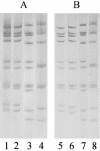Eight-year survey of human rotavirus strains demonstrates circulation of unusual G and P types in Hungary
- PMID: 14715788
- PMCID: PMC321674
- DOI: 10.1128/JCM.42.1.393-397.2004
Eight-year survey of human rotavirus strains demonstrates circulation of unusual G and P types in Hungary
Abstract
Between 1992 and 2000, a total of 4173 rotavirus-positive samples were collected from two areas of Hungary. Of these, 2020 specimens (48.4%) were analyzed for G serotype, using monoclonal antibody-based immunoassay and reverse transcription-PCR. By the two methods, 1789 samples were specified as G1 (62%), G2 (12.2%), G3 (1.4%), G4 (6.4%), G6 (1.0%), G9 (2.9%), or mixed infection (2.6%), and the remaining 231 (11.4%) could not be G typed. The linkage between G and P type, subgroup specificity, and RNA profile was investigated with a sample subset. Among these specimens, we identified both the four globally common strains (P[8],G1 subgroup II (sgII); P[4],G2 sgI; P[8],G3 sgII; and P[8],G4 sgII) and six uncommon strains (P[6],G4 sgII; P[9],G3 sgI; P[9],G6 sgI; P[14],G6 sgI; P[8],G9 sgII; and P[8],G9 sgI). All strains with P[8], P[6], P[9], and P[14] specificities had a long electropherotype, whereas most of those carrying a P[4] specificity were associated with a short electropherotype. Although once considered to be rare, P[9],G6 and P[8],G9 rotavirus strains represent potentially important new serotypes in Hungary.
Figures

References
-
- Armah, G. E., C. T. Pager, R. H. Asmah, F. R. Anto, A. R. Oduro, F. Binka, and D. Steele. 2001. Prevalence of unusual human rotavirus strains in Ghanaian children. J. Med. Virol. 63:67-71. - PubMed
-
- Bányai, K., J. R. Gentsch, D. D. Griffin, J. L. Holmes, R. I. Glass, and G. Szücs. 2003. Genetic variability among serotype G6 human rotaviruses: identification of a novel lineage isolated in Hungary. J. Med. Virol. 71:124-134. - PubMed
-
- Clark, H. F., P. A. Offit, R. W. Ellis, J. J. Eiden, D. Krah, A. R. Shaw, M. Pichichero, J. J. Treanor, F. E. Borian, L. M. Bell, and S. A. Plotkin. 1996. The development of multivalent bovine rotavirus (strain WC3) reassortant vaccine for infants. J. Infect. Dis. 174(Suppl. 1):S73-S80. - PubMed
Publication types
MeSH terms
Substances
LinkOut - more resources
Full Text Sources
Research Materials
Miscellaneous

